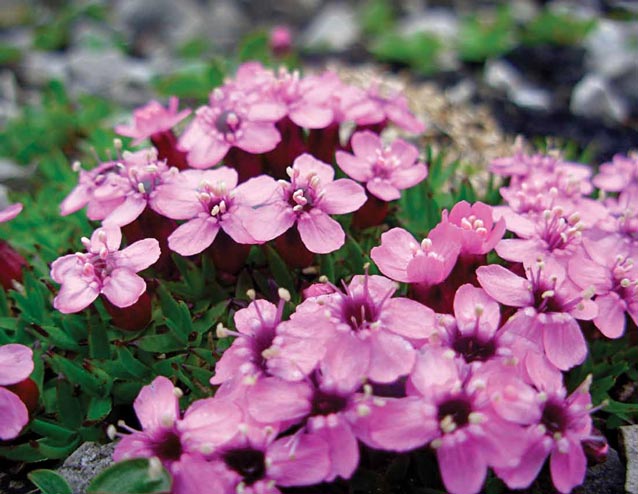
Tracy Feldman
On Wednesday, March 29, 1911, officials drove a copper spike in Kennecott, Alaska to complete construction of the Copper River and Northwestern Railroad that linked the Kennecott copper mines to the port of Cordova. That day was more than 100 years ago, and Kennecott is now part of the Wrangell-St. Elias National Park and Preserve (WRST). On the alpine ridges that look down on Kennecott, hikers will find moss campion plants (Figure 1), which were already centuries old on that historic day, even though each is only about the size of a dinner plate. We have been studying these plants for more than 17 years, but many of them will certainly still be alive when we, like the Copper River and Northwestern Railroad, are things of the past. As we describe below, we conduct research on this and another species to answer questions about the longevity and general ecology of tundra plants, as well as how they are being influenced by climate change in the Wrangells and across North America.
Moss campion (Silene acaulis, in the carnation family) begins life when a seed germinates to produce a seedling with two small seed leaves and a single tiny root. Each year, the main stem of the young plant produces a new whorl of leaves at its tip, and the root grows deeper. This stage, in which the plant has only a single above-ground growing point, may last for many years. Indeed, some of the plants we found in this stage 17 years ago are still in this stage today (Figure 2). If the plant survives, its single shoot will eventually branch to produce two tips, which themselves may eventually branch, and so on, to produce the multiple growing points you see if you closely examine a large plant (Figure 3). However, each branch elongates very little from the point at which it originated on the “parent” branch, giving larger plants a compact, pin-cushion-like shape. This growth form is adapted to the harsh tundra environment. In summer, the short branches keep the leaves close to the ground surface where the wind is lower and the air temperature is higher, even on cold and windy days. Moreover, the low growth form means the plant is quickly covered with snow in autumn, which insulates and protects the plant from the extremely cold and dry winter conditions.
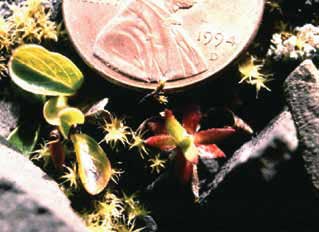
While the above-ground growing points are undergoing branching, the root tip may branch as well, to produce multiple roots. However, the plant retains a single taproot (Figure 4). This deep taproot is an adaptation to the unstable, rocky soil in which moss campion typically grows, the surface of which is often subjected to frost heaving in winter that would quickly destroy more shallow-rooted species. Overall, the form of a moss campion plant is like that of a miniature tree that has had its trunk shrunken and shoved into the ground, so that all we see when we look down on the plant are its branch tips and their whorls of leaves. In addition, we have found moss campion has a life cycle which also resembles that of a long-lived tree.
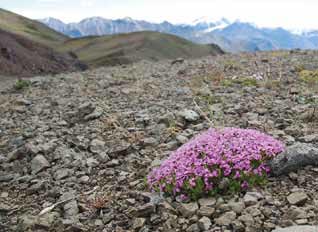
Rachael Mallon
So how do we know that these small plants are likely to be so old? Many of the largest plants that we marked 17 years ago are still alive today, so we know from direct observation that they live at least that long. But to better estimate the lifespans of these plants (which do not make anything equivalent to the annual rings of a tree that allow direct aging of individuals) we have measured the growth that each of hundreds of plants achieve in each year and also the fraction of plants of all sizes that survive from one year to the next (Figure 5). We measure the size of each plant as the surface area of the cushion, and record changes in that area from year to year as growth. Some plants also shrink, often due to exposure to cold winter conditions during snow-free periods (Figure 6).
Using this information, we can calculate, assuming the rates of annual growth, shrinkage, and survival have remained relatively constant in the past, how old a newly germinated seedling will be, on average, at successive sizes, or the so-called “age of residence” of a cohort in each size class (Cochran and Ellner 1986). Using this approach, we estimate that plants larger than about 6 inches in diameter (200 cm2 in area) are on average about 200 years old, and some of them may be substantially older (Morris and Doak 1998) (Figure 7). This longevity was a great surprise to us, and was the most interesting outcome of our initial work on moss campion. Given this longevity, when we go hiking in the mountains, we try to respect our elders, and avoid stepping on any moss campion plants.
In 2001, we greatly expanded our work and shifted our focus to the question of how climate determines the geographical distributions of tundra plants. Answering this question is important for predicting the ecological effects of the rapid ongoing climate change in Alaska and other northern regions. But we are equally interested in the more basic issue of why species have the distributions that they do. While some species of plants and animals have severely restricted ranges, many live across huge areas, and it is not clear why they “fail” outside this area: in other words, what sets the limits to their ranges? Thus, we sought to design a study that would let us understand what limited populations of moss campion across a large swath of its impressive range in western North America, including sites from Alaska’s North Slope to the Colorado Rockies (Figures 8-9).
We also expanded our work in another, crucial way: to strengthen our ability to generalize about climate effects, we added a second study species, the alpine bistort, Polygonum viviparum (also called Bistorta vivipara). This plant, a member of the buckwheat family, is also a tundra specialist in North America. Bistorts are reasonably long-lived, but their growth form is very different from that of moss campion. As with moss campion, we collect data on survival, growth, and reproduction for our bistort plants each year (Figures 10-11).
By 2006, we had collected data on a total of 35,386 plant-years for moss campion and 23,980 for bistorts. We then assembled this information and looked at what it indicated about climate effects on the basic ecological responses of the two species, as well as what these patterns told us about likely climate change effects. One of the most obvious effects we saw was that some demographic rates (i.e., birth, survival, and growth rates) deteriorated in populations closer to the southern range limit while others improved. In particular, survival and reproduction generally declined but growth was generally faster at the southernmost site, trends we saw in both species (Figure 13).
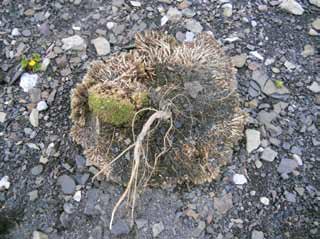
William F. Morris
We also wanted to ask whether climate was responsible for these spatial patterns. To do so, we used weather stations near each of our sites to obtain the mean growing season temperature for each year in each region, and we employed satellite data to estimate how long the ground was snow-free in each year, which determines the length of the growing season. Our results show that both growing season length and temperature have effects on many demographic rates (Figure 13), and that these effects largely explain the latitudinal patterns we see. Overall, both the warmest and the coolest conditions generally led to lower values of multiple demographic rates, while intermediate conditions resulted in better performance (Figure 13).
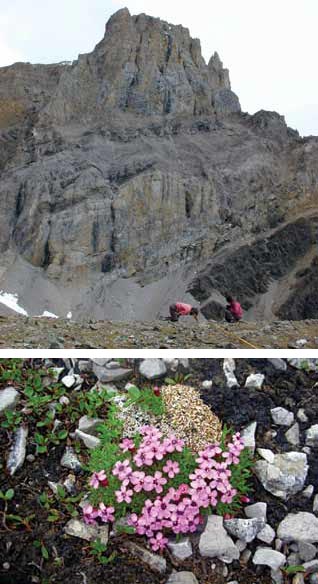
Fig 5 (top) and 6 (bottom): To measure growth, survival, and reproduction of moss campion plants, we establish transects that we revisit each year. Moss campion cushions shrink as well as grow. The grey and brown part of this plant died the previous year.
The final thing we did was to take the effects of climate on different demographic rates and ask what they mean for population growth, which results from the combined effects of all these rates. The results show that a broad range of intermediate climate conditions can support high population growth rates, but that when conditions are either too warm or too cool, populations are predicted to collapse. In a warming climate, this implies that with gradual warming, we should expect to see relatively stable populations of tundra plants, but past some climatic tipping point—which will not be the same for each species—we should expect rapid population declines. One value of this finding is that it explains a common observation of climate change scientists – while some species have shifted ranges and shown strong responses to ongoing climate change, many have not. Our work suggests that this is exactly what we should expect, but that the lack of responses we have seen in many species up to now is no guarantee of future stability.
Long-term ecological studies such as ours have a perverse logic: the more data you have already collected, the more mundane, but also the more useful, each new year of data becomes. We are lucky to have received continuing permission to work at all our sites, in particular WRST (Figure 14). Continuing financial support from the National Science Foundation means we will collect at least five more years of data in this study. Just as exciting is that our work in North America has interested European researchers: both moss campion and bistorts also grow in Europe, and we and European collaborators have now established moss campion study populations from the Spanish Pyrenees, to the Swiss Alps, to central and northern Sweden. Comparing the demography of plants in these sites with what we find in western North America will test whether we have identified the general mechanism setting the range limits of tundra plants, and provide an even richer set of climate regimes with which to understand effects of changing climate on plant distributions.
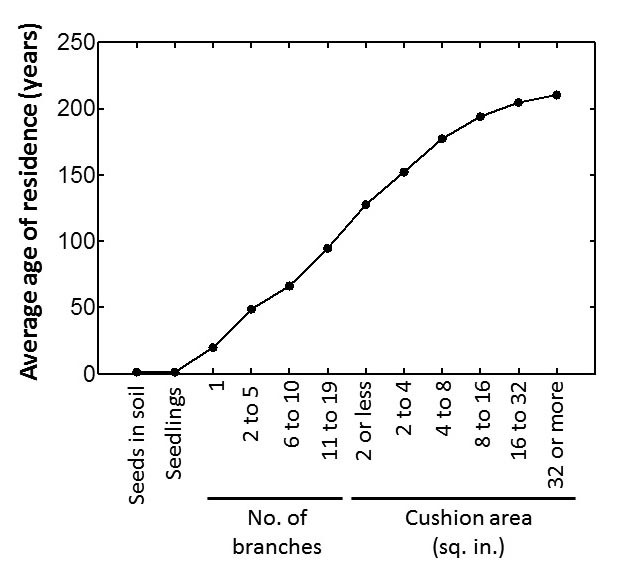
On Wednesday, March 29, 1911, officials drove a copper spike in Kennecott, Alaska to complete construction of the Copper River and Northwestern Railroad that linked the Kennecott copper mines to the port of Cordova. That day was more than 100 years ago, and Kennecott is now part of the Wrangell-St. Elias National Park and Preserve (WRST). On the alpine ridges that look down on Kennecott, hikers will find moss campion plants (Figure 1), which were already centuries old on that historic day, even though each is only about the size of a dinner plate. We have been studying these plants for more than 17 years, but many of them will certainly still be alive when we, like the Copper River and Northwestern Railroad, are things of the past. As we describe below, we conduct research on this and another species to answer questions about the longevity and general ecology of tundra plants, as well as how they are being influenced by climate change in the Wrangells and across North America.
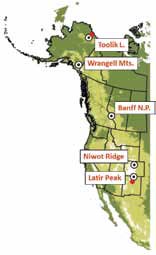
Figure 8. The sites of our expanded study of tundra plant ecology. From 2001 to 2006, we studied plants at all sites shown except Latir Peak, the southern-most. From 2007 onwards, we included sites at Latir Peak, but due to logistical constraints have stopped working in the Canadian Rockies. Red dots indicate the northernmost and southernmost locations of moss campion in western North America.
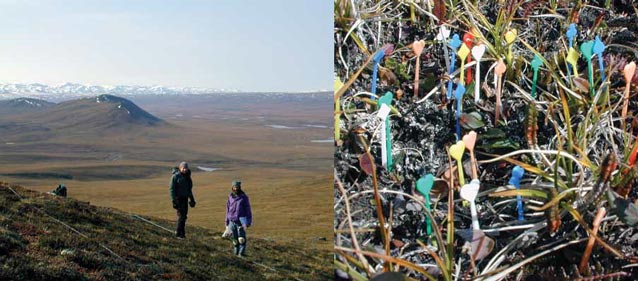
On Wednesday, March 29, 1911, officials drove a copper spike in Kennecott, Alaska to complete construction of the Copper River and Northwestern Railroad that linked the Kennecott copper mines to the port of Cordova. That day was more than 100 years ago, and Kennecott is now part of the Wrangell-St. Elias National Park and Preserve (WRST). On the alpine ridges that look down on Kennecott, hikers will find moss campion plants (Figure 1), which were already centuries old on that historic day, even though each is only about the size of a dinner plate. We have been studying these plants for more than 17 years, but many of them will certainly still be alive when we, like the Copper River and Northwestern Railroad, are things of the past. As we describe below, we conduct research on this and another species to answer questions about the longevity and general ecology of tundra plants, as well as how they are being influenced by climate change in the Wrangells and across North America.
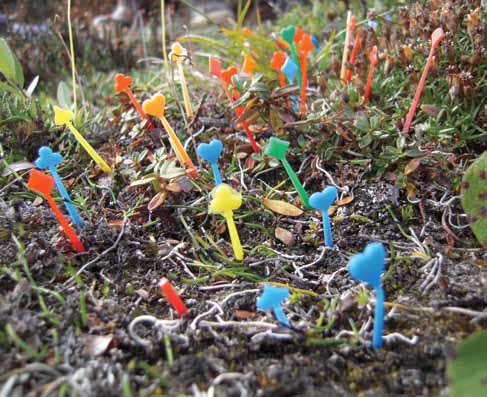
As with bistorts, we use multicolored party toothpicks to mark the smallest moss campion plants. In particular, we choose the areas around some large moss campion for intensive study of seedling appearance and survival. This photograph shows such a ‘mother plant’ in the upper right (covered with brown, upright seed capsules) and the toothpicks marking tiny offspring in the foreground (Fig 11).
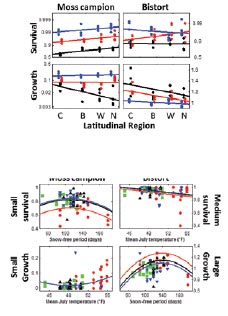
Figure 12. From south to north, survival increases but growth declines. Small, medium, and large plants are shown in black, red, and blue, respectively. Regions are Colorado (C), Banff National Park in Alberta, Cana-da (B), the Wrangell Mountains (W), and Toolik Lake, on the North Slope (N).
Figure 13. Responses of one survival rate and one growth rate for each species to mean July temperature or snow-free period. Colors show regions: red = Colorado, green = Banff, black = Wrangells, and blue = the North Slope.
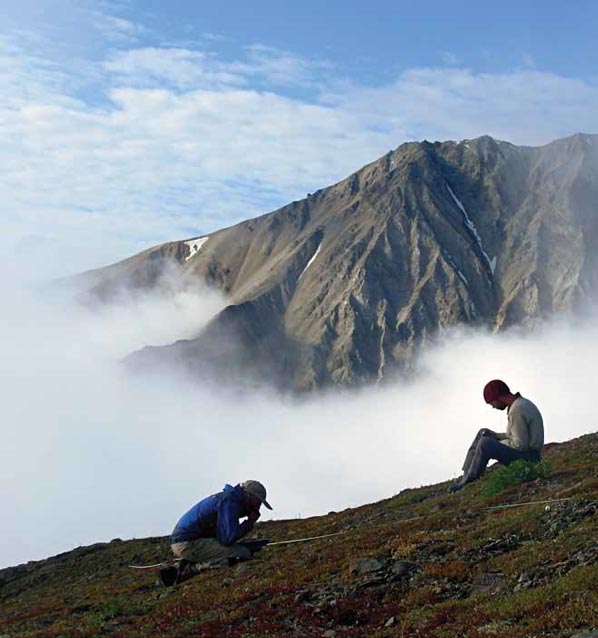
Rachael Mallon
Figure 14. While we spend much of our time in the field staring at the ground or at handheld computers, this long-term project also means we spend many weeks in some of the most beautiful parts of the Alaskan mountains each year.
Part of a series of articles titled Alaska Park Science - Volume 12 Issue 1: Science, History, and Alaska's Changing Landscapes.
Last updated: October 26, 2021
